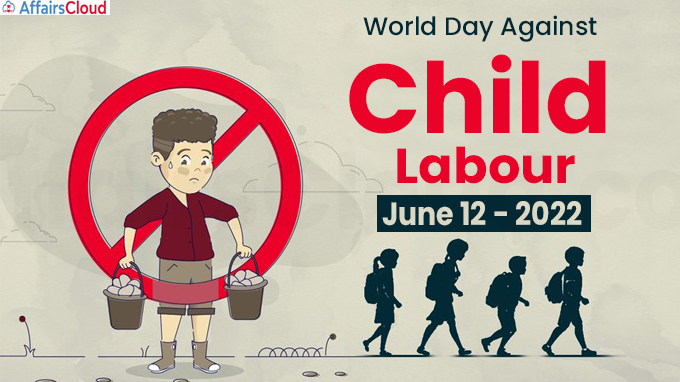
The United Nations(UN)’s World Day Against Child Labour is annually observed across the globe on 12th June to create awareness about the harmful effects of child labour on individuals. The day also aims to eradicate work that deprives millions of children of their rights to decent education, working conditions and living wages.
The theme of World Day Against Child Labour 2022 is “Universal Social Protection to End Child Labour”.
- The 2022 theme calls for increased investment in social protection systems and schemes to establish solid social protection floors and protect children from child labour.
Background:
i.The World Day Against Child Labour was launched in 2002 by the International Labour Organization (ILO), a United Nations(UN) agency mandated to advance social and economic justice by setting international labour standards.
ii.The first-ever World Day Against Child Labour was observed on 12th June 2002.
- The day was established to highlight the plight of child labourers and what can be done to help them.
- One of the major aims set for the ILO at its founding in 1919 was the abolition of child labour.
Week of Action against Child Labour – 3 to 12 June 2022
i.Week of Action against Child Labour, from 3rd to 12th June 2022 has been marked as a part of the celebration of the World Day Against Child Labour.
ii.As a part of this week, events and activities were organised around the world to provide an opportunity to showcase progress on the elimination of child labour.
SDG and Child Labour:
Target 8.7 of the Sustainable Development Goals (SDGs) adopted in 2015, calls out to “Take immediate and effective measures to eradicate forced labour, end modern slavery and human trafficking and secure the prohibition and elimination of the worst forms of child labour, including recruitment and use of child soldiers, and to end child labour in all its forms by 2025”.
Child labour:
i.Child labour is work carried out to the detriment and endangerment of a child, in violation of international law and national legislation.
ii.Child Labour includes,
- All “unconditional” worst forms of child labour, like slavery or practices similar to slavery, the use of a child in armed conflict, prostitution and pornography, or illicit activities.
- Work done by children under the minimum legal age for that type of work, as defined by national legislation in accordance with international standards.
- Labour that jeopardizes the physical, mental or moral well-being of a child (hazardous work)
Note: All works by children are not classified as Child labour that is targeted for elimination, the participation of Children or adolescents’ in works that don’t affect their health or personal development or interfere with their schooling is considered as being positive.
Joint report of ILO & UNICEF:
The joint report of ILO and United Nations Children’s Fund (UNICEF) titled “The role of social protection in the elimination of child labour: Evidence review and policy implications” was released at the 5th Global Conference on the Elimination of Child Labour hosted by South Africa in May 2022.
- The report highlights that social protection, by helping families cope with economic or health shocks, reduces child labour and facilitates schooling.
Prevalence of Child Labour:
i.Africa tops the list of Children in Child labour with 5% (72 million) followed by Asia and the Pacific ranked 2nd with 7% )62 million.
ii.The remaining child labour is distributed among the Americas (11 million), Europe and Central Asia (6 million), and the Arab States (1 million).
iii.At the beginning of 2020, 1 in 10 children aged 5 and over were involved in child labour worldwide. This is estimated to be around 160 million children (63 million girls and 97 million boys).
iv.The number of children in child labour has declined by 85.5 million between 2000 and 2020, from 16% to 9.6%.




